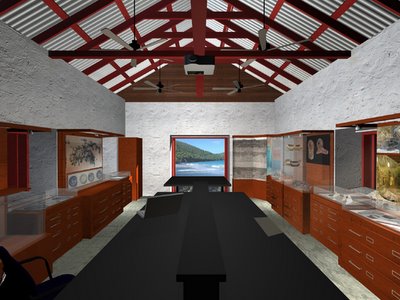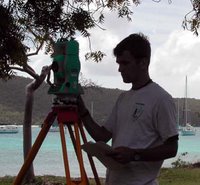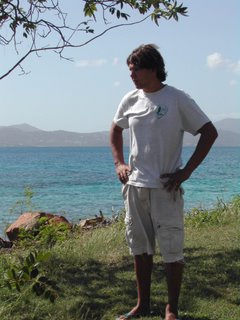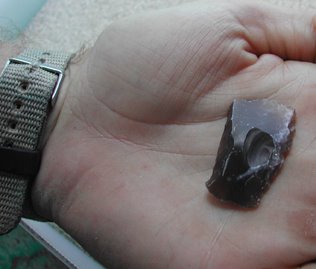
Exciting weeks-- We find the Prehistoric Caves, Evidence from the 1733 Slave Revolt, and an Underwater Cannon that may Predate the Danes dating to the 1600s. Graphing C-14 dates give New Insights into the Pre-Columbian Peoples at Trunk Bay.
This week we are analyzing and cataloging the artifacts we unearthed in our Caneel Bay shovel tests. It is painstaking work but is necessary to complete our research and ensure that the artifacts are easily accessible to future archeologists who might continue after our efforts. Our first step in this process is cleaning the artifacts, which was done with the help of two volunteers. We then analyze the artifacts from each unit and level separately. We weigh and count everything we find. In some cases, we might discard some objects, such as shells that are not related to the archeological record and therefore not diagnostic. We still have to ID them, record their weight, and count each species. Everything we keep we sort by the thousands of diagnostic attributes they may fall into, and then assign each sorted object(s) a catalog number. Lots of prehistoric pottery was recovered and interesting stone tools (one of which is pictured in a previous blog entry). There are also several stone grinders and numerous stone flakes that indicate tool creation. During our analysis, we discovered one artifact that was particularly unique and which we incorrectly thought was a stone flake at the dig site. Upon closer examination, Ken determined it was actually a French gunflint probably for an eighteenth century musket. It is possible that this artifact along with the early colonial pottery is evidence of the French troops who were brought to St. John to quell the slave revolt of 1733.
Connor and I also had to return this week to examine the caves we found for evidence of prehistoric occupation and to explore for more caves. This time we remembered to bring a headlight. This helped a great deal, as we were able to actually see inside the caves. In the first cave, Connor found one small potsherd on the surface. It was exciting to discover that these caves were used by Tainos or perhaps their ancestors. At the next rock overhang, we found several more potsherds and charcoal. We also found two more small caves, one of which had a Cittarium pica shell, locally known as whelk, which was a prehistoric food source, but could have also been the former home of a Soldier Crab. I hope that future investigations will reveal good diagnostic artifacts and give us deeper knowledge into the extent of occupation and the caves' use.

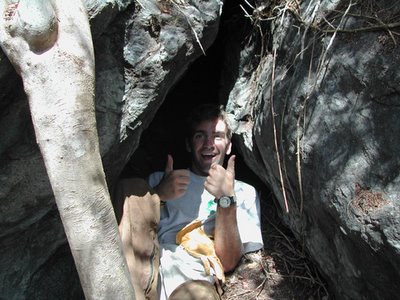
A couple of weeks ago Ken and Susanna followed up on a lead that park biologist Thomas Kelley discovered while diving in the park. Thomas reported spotting what looked like a small cannon. Upon inspection it appears that, indeed, it is a cannon but of the most unusual design. It may be possible that the cannon is from the 17th century as the design and pottery in the area appear to go back to a pre-Danish era. More information will be forthcoming about the cannon as investigations continue.
 Over these last two weeks, we have also had the pleasure to host Dr. Emily Lundberg and her husband Bert and his daughter Deborah. Dr. Lundberg came from Montana to work with Ken on the Trunk Bay ceramics. We interns just recently completed entering some several thousand ceramic data records into an Access program so they could start asking the data some questions. While we were out in the field, Bert and Deborah addressed the lab’s visitors allowing Emily and Ken a chance to focus on the work. Their goal is to define the ceramic chronology of the Virgin Islands from AD 800 to 1200. The dates for the site became much clearer this week after Ken graphed out the fifteen C-14 dates. He found that excavations conducted for the ramp that begins at the fee booth, the septic tank next to the concession area, and the present men’s bathroom all clustered within a 200-year period beginning in AD 1000 and ending around AD 1200. Two other sectors of the site were found to date to AD 800-1000.
Over these last two weeks, we have also had the pleasure to host Dr. Emily Lundberg and her husband Bert and his daughter Deborah. Dr. Lundberg came from Montana to work with Ken on the Trunk Bay ceramics. We interns just recently completed entering some several thousand ceramic data records into an Access program so they could start asking the data some questions. While we were out in the field, Bert and Deborah addressed the lab’s visitors allowing Emily and Ken a chance to focus on the work. Their goal is to define the ceramic chronology of the Virgin Islands from AD 800 to 1200. The dates for the site became much clearer this week after Ken graphed out the fifteen C-14 dates. He found that excavations conducted for the ramp that begins at the fee booth, the septic tank next to the concession area, and the present men’s bathroom all clustered within a 200-year period beginning in AD 1000 and ending around AD 1200. Two other sectors of the site were found to date to AD 800-1000.
